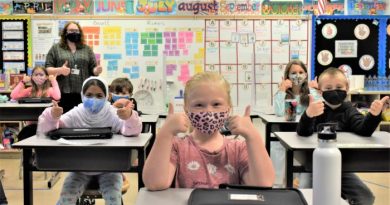School Preparedness: Earthquake
The Great ShakeOut: Many FUSD schools participate in the world’s largest earthquake drill, the ShakeOut, held on the third Thursday of October.
Earthquake drills can be held any school day as determined by the site.
Be Informed
- Find school resources from ShakeOut.org
Make a Plan
- Listen to your teacher during drills
- “Drop, Cover, and Hold On” is the appropriate action
- The annual ShakeOut is an opportunity to practice how to protect ourselves during earthquakes
During an Earthquake
DROP where you are, onto your hands and knees
- This position protects you from being knocked down and reduces your chances of being hit by falling or flying objects.
COVER your head and neck with one arm and hand
- If a sturdy table or desk is nearby, crawl underneath for shelter
- If no shelter is nearby, crawl next to an interior wall
- Stay on your knees; bend over to protect vital organs
HOLD ON until shaking stops
- Under shelter: hold on to it with one hand; be ready to move with your shelter if it shifts
- No shelter: hold on to your head and neck with both arms and hands
After an Earthquake
- Evacuate if necessary, helping the injured and preventing further injuries or damage
- Look around your environment to identify any new hazards such as leaking gas lines, damage to the building, water or electric lines, or other things that may be dangerous, especially if there are aftershocks Source: https://www.fremont.k12.ca.us/earthquake
The Earthquake Country Alliance has worked with experts in earthquake science, preparedness, and mitigation to develop this step-by-step guide for staying safe before, during, and after an earthquake.
Start with the simple tips within each step and then build on your accomplishments. For example, in Step 1 you can move heavy, unsecured objects from top shelves onto lower ones. This will only take minutes to complete! A simple action in Step 4 is to call your agent to learn about earthquake insurance options. To practice how to be safe during earthquakes (Step 5) you can register to participate in Great ShakeOut Earthquake Drills.
For California, the Seven Steps are also featured within the Staying Safe Where the Earth Shakes booklets, available in English, Spanish, and Chinese (statewide) and 10 regional versions.
Before the next big earthquake we recommend these four steps that will make you, your family, or your workplace better prepared to survive and recover quickly:
| Step 1: Secure your space by identifying hazards and securing moveable items. |
|
| Step 2: Plan to be safe by creating your emergency plan and deciding how you will communicate. |
|
| Step 3: Organize emergency supplies in convenient locations. |
|
| Step 4: Minimize financial hardship by organizing important documents, strengthening your property, and considering insurance coverage. |
During the next big earthquake, and immediately after, is when your level of preparedness will make a difference in how you and others survive and can respond to emergencies:
| Step 5: Drop, Cover, and Hold On or other recommended actions such as Lock (wheels), Cover, and Hold On – if you feel shaking or get an alert. |
|
| Step 6: Improve safety after earthquakes by evacuating if necessary, helping the injured, and preventing further injuries or damage. |
After the immediate threat of the earthquake has passed, your level of preparedness will determine your quality of life in the weeks and months that follow:
| Step 7: Reconnect and Restore daily life by reuniting with others, repairing damage, and rebuilding community. |
source: https://www.earthquakecountry.org/sevensteps/






